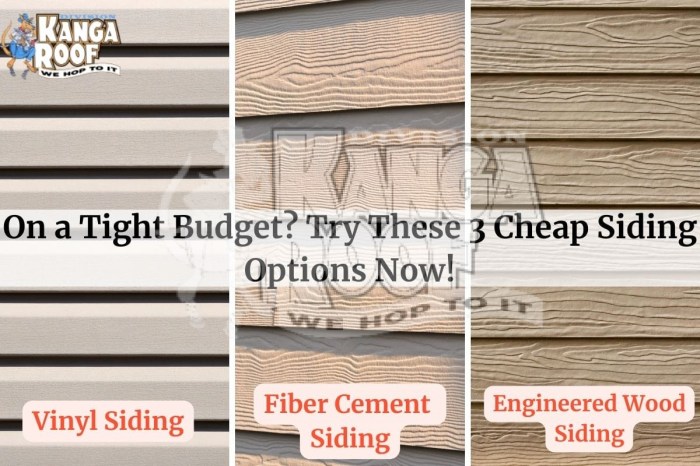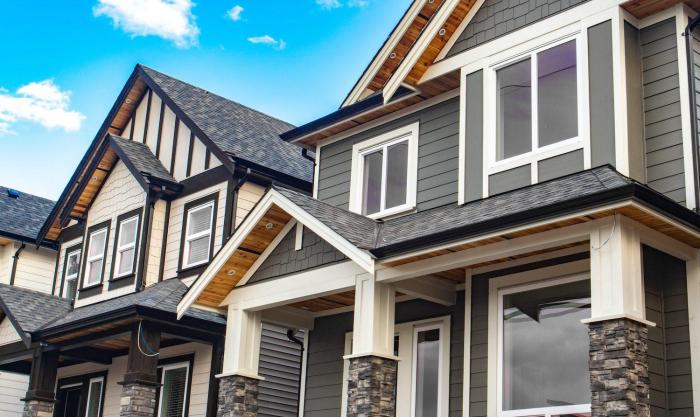Delve into the world of affordable home siding options as we uncover a variety of materials and maintenance tips to enhance your living space. This guide will provide valuable insights to help you make informed decisions for your home.
Learn about different types of siding materials, their pros and cons, energy efficiency considerations, and installation tips to transform your house affordably and efficiently.
Types of Affordable Home Siding Options

When it comes to choosing affordable home siding options, there are several materials to consider. Each type has its own pros and cons, so it's important to weigh your options carefully before making a decision. Below are five different types of affordable home siding options along with their characteristics:
Vinyl Siding
- Pros: Affordable, low maintenance, available in various colors and styles.
- Cons: Can crack or fade over time, not as durable as other materials.
Fiber Cement Siding
- Pros: Durable, fire-resistant, can mimic the look of wood or stone.
- Cons: More expensive than vinyl, requires repainting every few years.
Wood Siding
- Pros: Natural look, environmentally friendly, can last for decades with proper maintenance.
- Cons: Prone to rot, pests, and requires regular upkeep like painting or staining.
Metal Siding
- Pros: Durable, low maintenance, resistant to pests and rot.
- Cons: Can dent or scratch easily, may not be as visually appealing as other options.
Engineered Wood Siding
- Pros: Cost-effective, durable, can mimic the look of real wood.
- Cons: Susceptible to moisture damage, may require more maintenance than other materials.
Cost-Effective Maintenance Tips

Maintaining affordable home siding options is essential to prolong their lifespan and keep your home looking its best. By following some cost-effective maintenance tips, you can ensure that your siding stays in great condition for years to come.
Frequency of Maintenance
- Vinyl Siding:Vinyl siding is relatively low maintenance and typically only requires annual cleaning with a mild detergent and water to remove dirt and grime.
- Wood Siding:Wood siding needs more frequent maintenance, including repainting or re-staining every 3-7 years, depending on the climate and exposure to the elements.
- Fiber Cement Siding:Fiber cement siding is durable but may require repainting every 10-15 years to maintain its appearance and protect against moisture.
- Metal Siding:Metal siding is quite low maintenance and may only need occasional cleaning to remove dirt and debris.
Cost Comparison
When considering the cost of maintenance for different siding options, it's important to factor in not only the initial cost but also the long-term maintenance expenses. While vinyl siding may have a lower upfront cost, it may require more frequent cleaning compared to other options like metal siding
Energy Efficiency of Siding Materials
When it comes to the energy efficiency of siding materials, it is important to consider how different options can impact your home's energy consumption. Choosing the right siding material can help you save on heating and cooling costs in the long run.
Impact of Siding Materials on Energy Consumption
Different siding materials have varying levels of energy efficiency. For example, insulated vinyl siding can provide better insulation for your home, reducing heat loss in the winter and heat gain in the summer. On the other hand, aluminum siding may not offer as much insulation, leading to higher energy bills.
Recommendations for Choosing Energy-Efficient Siding Options
- Opt for insulated siding materials such as vinyl or fiber cement to improve energy efficiency.
- Consider the climate in your area when choosing siding materials - for colder climates, opt for materials with better insulation properties.
- Look for siding materials with a high R-value, which indicates better thermal resistance.
- Regularly maintain and repair your siding to ensure optimal energy efficiency over time.
Installation Considerations
When it comes to installing affordable home siding, there are several key factors to consider to ensure a successful and cost-effective project. Whether you choose to tackle the installation yourself or hire a professional, understanding these considerations is crucial.
Step-by-Step Guide for DIY Siding Installation
- Prepare the surface: Ensure the surface is clean, dry, and free of any debris before starting the installation process.
- Measure and cut the siding: Take accurate measurements and cut the siding panels according to the dimensions of your walls.
- Install the starter strip: Begin by installing the starter strip at the bottom of the wall to provide a base for the siding panels.
- Attach the siding panels: Secure the siding panels to the wall using nails or screws, making sure they are level and properly aligned.
- Finish with trim pieces: Complete the installation by adding trim pieces around windows, doors, and corners for a polished look.
Importance of Professional Installation versus DIY for Cost-Effectiveness
- Professional installation: While hiring a professional may seem more expensive upfront, it can save you time and ensure a high-quality finish.
- DIY installation: Opting for a DIY approach can be cost-effective if you have the necessary skills and tools, but it may require more time and effort on your part.
- Consider the complexity: For simple siding projects, DIY installation may be sufficient, but for more complex designs or materials, professional help is recommended.
Closure
In conclusion, affordable home siding options offer a range of choices to upgrade your home's exterior without breaking the bank. By understanding the different materials and maintenance requirements, you can make the best decision for your property. Enhance your home's curb appeal and energy efficiency with these cost-effective solutions.
Detailed FAQs
What are the most common types of affordable home siding options?
Common affordable siding options include vinyl, fiber cement, wood, metal, and engineered wood.
How often do I need to maintain affordable home siding options?
The maintenance frequency varies by material, but generally, annual inspections and cleaning are recommended for longevity.
Is professional installation necessary for affordable home siding?
While DIY installation is possible, opting for professional installation ensures proper fitting and can be more cost-effective in the long run.









